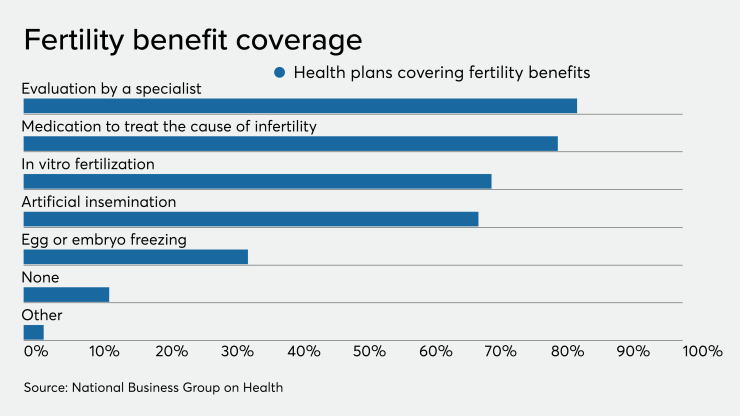Katie Goad got a job for the exclusive purpose of using fertility benefits.
Goad had her fallopian tubes removed — which prevents her from conceiving naturally — after giving birth to her first child. She knew she would need to pay for in vitro fertilization if she wanted to have another baby. After getting laid off from her full-time job, the possibility of paying for the procedure out of pocket seemed unlikely. Until she came across a news article about the fertility benefits at Starbucks.
“I didn’t want to sacrifice my family's financial future to have the possibility of IVF,” she says. So Goad eventually landed a part-time barista job working 20 hours a week at a Starbucks near her home in Cartersville, Georgia.
“I was honest with them in my interview about what my goal was, and what my intentions were,” she says.
A growing number of employees, like Goad, would consider switching jobs to use fertility benefits. Infertility is a widespread problem — out of every 100 couples, 12 to 13 will have trouble becoming pregnant, the U.S. Department of Health and Human Services reports. Employers including
Providing services to treat infertility could be a game changer for employers. Indeed, about 64% of women making less than $50,000 annually would switch jobs for better fertility benefits, according to a

I didn’t want to sacrifice my family's financial future to have the possibility of IVF.
Starbucks, which recently
Goad says she paid about $400 out-of-pocket for IVF, which would have cost her more than $16,000 without the benefit.
She left her job at Starbucks during the third trimester of her pregnancy and gave birth to her son in September. For now, she’s taking time off to be with her children. But she would consider going back to Starbucks to use their fertility and other benefits.
“I would do it in a heartbeat,” she says. “They offer it, and I want to use it.”
Stories like Goad’s are becoming more prevalent as fertility benefits have undergone a revolution over the last few years. While some companies have been covering services like IVF under their health plans for many years, numerous employers are moving to offer newer fertility benefits to workers such as surrogacy reimbursement and egg freezing — or expanding the coverage they already have in place.
Nearly nine-in-10 employers (87%) cover some kind of infertility benefit through their health plan, according to data from the National Business Group on Health. Of that group, about 71% offer IVF, 69% offer artificial insemination and 34% cover egg freezing. The vast majority cover evaluation by a specialist (84%) and medication to treat the cause of infertility (81%). Just under half of employers offer surrogacy benefits.

This year, Liberty Mutual expanded its fertility benefits coverage from $30,000 to $45,000 and eliminated eligibility requirements for infertility diagnoses. The company also launched a new surrogacy benefit, providing employees with $20,000 for the service, capped at a lifetime max of $40,000. The insurance company also expanded its adoption assistance program.
“When we look at our benefits, we take a pretty holistic approach to what we are offering. We want to ensure that as our employees’ needs evolve, our benefit plans evolve,” says Francis Hyatt, executive vice president and manager of enterprise talent practices at Liberty Mutual.
While there are a number of reasons why employers decide to invest and expand these benefits, attracting and retaining employees is key. These benefits are particularly appealing to millennials and younger generations, says Dr. Louise Short, national clinical leader at Strategic Benefit Advisors, a member company of Brown & Brown.
“Studies show that fertility benefits are very important for millennials in terms of who they actually select as an employer and the stickiness of keeping millennials employed,” she says.
There are also health reasons backing why employers should offer fertility benefits, Short adds. Employers that provide workers with access to the highest-quality providers can help prevent multiple births, which sometimes have greater complications.
There is an ongoing evolution of how benefits are structured, Short says. “I think employers are getting a little bit more progressive in how they put together benefits."
There are a number of providers that can help employers structure these benefits thoughtfully. More than ever, employers have vast choices when it comes to selecting a vendor to help structure their fertility benefits. The market is also getting more competitive. Vendors including Progyny, Carrot Fertility, Ovia, Maven, WINFertility and Nubundle all provide fertility solutions for employers.
Progyny, for example, works with large companies including PayPal, Microsoft and Facebook. David Schlanger, CEO of Progyny, says the company works directly with employers’ health plans to structure the benefits. They also have patient care coordinators who can help employees throughout their journey. Being able to provide fertility benefits provides a sense of pride for employers, he adds.
“It’s really a family-building benefit,” he says.

Fertility benefits also help employees financially. The average IVF cycle costs $12,000, according to the American Society for Reproductive Medicine — and offering fertility benefits can help ease that burden. Schlanger says to create a benefit program that can maximize outcomes from employees, companies need to combine financial incentives with appropriate clinical and emotional support.
“If you provide appropriate financial, emotional and clinical support, a much higher percentage of those who need treatment will get treatment,” he says.
For Cadence Design Systems, a software company based in Silicon Valley, offering fertility benefits through Progyny has helped them remain competitive with other tech firms. Fertility benefits, along with the rest of the company’s benefits package, helps to support attraction and retention rates, says Cindy Conway, benefits group director at Cadence.
“I think it definitely puts us in a very competitive position,” she says. “Silicon Valley in particular tends to be early adopters to interesting benefits like this.”
But not all fertility benefits are created equal. Employers need to think critically about how they structure their benefits so they don’t exclude some workers.
Meghan Lapides, senior vice president of HR at Foursquare, found herself in a bind when she decided to freeze her eggs. As a single woman, Lapides had to pay out of pocket for the service because the company’s coverage at the time only covered couples. Lapides had to shell out a significant amount of money for the service.
“It doesn’t speak to the values of our organization which is a very inclusive place,” she says. “I started having a conversation with our CEO about how to cover it.”
Motivated by her own experience, Lapides decided to work personally on revamping Foursquare’s benefits. The employer eventually decided to use Carrot Fertility — a provider serving companies including Slack and Stitch Fix — to administer the benefit. When Lapides decided to freeze her eggs the second time, Carrot helped bring the cost down significantly.
“Not having the stress of how the bills are going to get paid made the second experience a lot easier,” she says.

Carrot also provided emotional support throughout the process, which Lapides says was missing when she froze her eggs on her own. Women in that situation have the potentially stressful and painful experience of giving themselves multiple shots to aid the process. Having a benefit provider that offered emotional support helped her feel better, she says.
“When you’re standing in your bathroom about to give yourself a shot for the first time, you get a little bit of extra help,” she says.
Paypal started using Progyny partly because of the emotional support access offered to employees. The payment tech company employs about 12,000 workers in the U.S. who have access to Progyny via its partnership with UnitedHealthcare, Paypal’s insurer.
Access to care coordinators for both emotional and medical support was important to PayPal, says Suzanne Ledesma, the company's benefits director for the Americas. More than 200 employees have utilized the service since the employer began offering it in 2018.
“It can be pretty emotionally draining, not to mention financially draining,” she says. “The patient care advocate is really managing everything through the process, including answering questions along the way that you might not even know to ask.”

It came at a time when we really needed the additional financial support.
PayPal also offers surrogacy and adoption assistance benefits as a way to support workers from a variety of families and backgrounds. “I think it really comes down to our core values as an employer, we really strive to provide offerings in our benefits and rewards packages that are relevant to all kinds of families,” Ledesma says. “Regardless of sexual orientation, medical status or medical condition — we want to support everyone.”
Companies covering fertility services for same-sex couples are also increasing — the number is expected to reach 81% in 2019, data from Willis Towers Watson indicates. Michael Proppe, a principal at the consulting firm PwC, and his husband, began searching for a surrogate in 2014.
Proppe equates the process of locating a surrogate to a second full time job — it depleted the couple’s time and money. Communicating with fertility clinics, lawyers and agencies, and the cost of services, all was tiresome. It would take the couple four years from start to finish. Proppe's employer, however, was helpful: PwC has a benefit that covers up to $25,000 in surrogacy expenses.
The company was “supportive of the flexibility I needed to work through the whole family process,” he says. “It came at a time when we really needed the additional financial support.”







